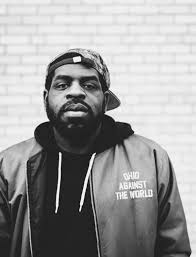by EMILIO JESUS TAIVEAHO
Hanif Abdurraqib, They Can’t Kill us Until They Kill Us (Two Dollar Radio, November 2017), pp. 236
“And what a year 2016 was. Oh, friends, those of you who are still with us, what a year we survived together.”
– Hanif Abdurraqib
“It’s after the end of the world/ Don’t you know that yet?”
– Sun Ra
Living in the United States in 2016—and experiencing daily life in spaces saturated by national news, from trains to college campuses to apartment complexes to public parks—my flesh felt a world falling to pieces. This is not to say that it doesn’t feel that way now, or that it didn’t feel that way before—and I recognize that these words conjure a cliché—but, at least as I remember it, things were changing that year. A rupture felt near, that year. The bubbling, bubbling, bubbling of our shared, settler-colonial, parasitic phantasmagoria felt more palpable on the streets, in supermarkets, in casual conversation, in quotidian life, that year.
This was, in part, due to the surging deluge of hyper-visible violence against (criminalized) Black and Brown Bodies, the widespread normalization (and acceptance and celebration) of xenophobic and jingoistic discourse, an incessant barrage of hate crimes, police brutality, mass shootings, the results of the presidential election, and the continued international championing of nationalism, extraction, and big business. That fall, in Eau Claire, Wisconsin—a small town nestled in the heart of the Midwest, where I was then an undergraduate student—students of color were afraid to go to school, anti-racist protests were silenced, and trucks decorated with confederate flags paraded the streets. Amidst all of this, the music that emerged from this cultural landscape—or that gained new life through it—became a refuge; something akin to a bivouac on an alpine cirque: a site of cliffside comfort perched upon a transforming landscape, where one witnesses water carve jagged rock in a deft dance of difference, defiance, and impermanence; where change occurs through agonism, resistance, and movement.
Two years later, as I recollect the sonic sites of refuge that helped me get through those turbulent times, what comes to mind are the triumphant trumpets throughout Solange’s A Seat at the Table; the ecstatic lyrical acrobatics of Chance the Rapper’s “Blessings”; Noname’s brazen beats; the lush guitars that texture Frank Ocean’s Blonde; and so on. Here, the resonances of Black Life and Black Survival and a Black Future ring loudest, imbibing me with a sense of careful optimism. In retrospect, that tumultuous year taught me, more than anything, that when the world is falling to pieces, music becomes a site of survival—a site of marronage, a liminal undercommunal territory where one can breathe.
*
Although this hasn’t always been the case, over the last few years I have grown to value and cherish and seek life. Like Édouard Glissant or Joanne Kyger, I want to be in the world, to live and experience and feel, profoundly. Because of this, I am drawn to art that speaks to me concretely; art that invaginates thought and helps me develop a richer understanding of experience, actuality, and life. Given that we are deeply embedded in fluctuating social systems that influence and shape our cognition and perceptions, art that speaks to life and experience is necessarily precarious, present, and social. With this in mind, I’d like to state, quite simply, that Hanif Abdurraqib is an artist, as his latest release, They Can’t Kill Us Until They Kill Us, published by Two Dollar Radio, testifies. A series of interrelated, timely meditations, They Can’t Kill Us Until They Kill Us charts the circumvolutions of life and culture in the United States in the wake of 2016, mapping a (desiring) cartography of music, film, sports, and embodied experience. In Abdurraqib’s own words, the collection, “more than anything, is about everything and everyone that didn’t get swallowed by the vicious and yawning maw of 2016, and all that it consumed upon its violent rattling which echoed into the year after it and will surely echo into the year after that one.” Abdurraqib’s lyrical fractals—which range from commentaries on Prince’s connection to the cosmos, to the politics (and ontological repercussions) of representation and material history, to memories of growing up in Ohio, to tributes and eulogies, to ruminations on culture—probe the intersections between media, identity, place, and community, elucidating the intimate relationship between popular culture and quotidian life.
Throughout this dexterous ensemble of essays, Abdurraqib navigates through the riffs and rifts of meaning and experience, tracing the production of signification through embodied encounters—from concerts to police stops to the feeling of phone screens and headphones in lonesome airport layovers. This is to say that, in contradistinction to the traditional cultural critic who comments from a fixed, somewhat-despotic perspective (dissecting and critiquing from a distance), Abdurraqib lives with and through the elements of culture he engages, expressing, through euphonious sentences, flows of life, desire, and subjectivity. This is particularly true of his music criticism, which is both passionate and critical, involved and sophisticated, and forms the core of the collection. Through essays like “Under Half-Lit Fluorescents: The Wonder Years and The Great Suburban Narrative,” “Fall Out Boy Forever,” “Nina Simone Was Very Black,” and “Johnny Cash Never Shot a Man in Reno. Or, The Migos: Nice Kids from the Suburbs,” it is evident that we are encountering the results of a life-long engagement with the generative capabilities of music (particularly hip-hop and pop-punk). Recognizing that the consumption of music is just as important as its production, Abdurraqib writes from the standpoint of the spectator: a member of the multitude, the crowd. Importantly—as illustrated by his exegesis of Chance the Rapper’s exuberant persona, or through his review of Cute Is What We Aim For’s 10-year anniversary tour—this allows readers to recognize that cultural meaning is unstable and prone to change depending on the scenario of the performance, a notion that forefronts the importance of the bodies on the other end of the transmission.
In the essay “Schoolboy Q wants white people to say the word,” Abdurraqib, writes:
…& on the anniversary of Biggie’s death we was playing Biggie’s music real loud on the speakers in the dorm community & we let it spill out into our dorm hallway because we both grew up rapping this shit through headphones & eventually more bodies piled into the room & they were mostly white kids who we made friends with because when you’re all piled on top of each other in the same building there ain’t much else to do & the song “Niggas Bleed” came on the playlist & Biggie raps “N****s bleed just like us” at least that’s what I wanted to hear when I looked around the room but everyone who rapped it in the room filled in the blanks & then again & then again & sometimes louder & I don’t know who the “us” was supposed to be in the rhyme anymore…
As this vignette illustrates, listening to music is a shared experience, and songs of refuge can change drastically depending on the web of relations—the people, the room, the moment in history—that contextualize our experience. What we love can be dissociating, under certain circumstances. This notion is consequential because it foregrounds that who we listen with is often just as important as who or what we listen to. At the same time, Abdurraqib’s passage points to the ongoing effects of the United States’ violent, settler-colonial history, which institutes asymmetrical power relations that systematically disenfranchise Black Subjects while appropriating Black Art and Black Aesthetics—a topic which is further explored throughout the collection.
Presenting a snapshot that summarizes 2016, in the essay “They Will Speak Loudest of You After You’ve gone,” Abdurraqib writes:
It is summer and white people are sad on the internet about black people dying again. This time, louder than usual. Everything on social media is in all caps, sometimes with accompanying videos of the deaths in question. In New Haven, Connecticut, the white woman who cut in front of a young black girl at the market waves her arms in the air and asks when it all will end, this seemingly endless parade of black people dying at the hands of the state. At a protest, a white person is all emotion, pulling at his shirt and shouting into a megaphone to a crowd of young people, mostly black. And everyone is jumping and pointing at the house on fire without considering there are people inside.
Consequentially, here, we are pointed towards some of the internal contradictions of neoliberalism; citizens are often outraged in social media, performing tolerance through disembodied platforms, but forget to be mindful of their real conditions of existence, of their daily actions and reactions in physical, public spaces—precisely in the spaces where actions matter most. This impasse underlines the profound power of everyday life, fore-fronting the quotidian nature of political participation. Politics, seen from this perspective, is a series of micro-events: relations and interactions. The political model engendered from this vantage point, therefore, urges self-reflection and a return to the body as a de-colonial option; de-prioritizing performative large-scale events (such as elections) that are often presupposed to be the paradigms of “democratic” political participation. In other words, in order to influence consequential social change, it becomes quintessential for us to be mindful of our concrete conditions of existence, situating ourselves—as bodies—in relation to the social matrix from which we emerge and to which we belong, recognizing how others perceive us and the benefits those perceptions may (or may not) bestow upon us. For many of us—whites and non-Black People of Color—this means confronting our complicity and privileges; confronting the survivance of a phantasmagoria that deeply informs our being (and our possibilities of becoming). To borrow a metaphor from Abdurraqib, our house is on fire: we can see it, feel it, and smell it; our energies are better spent doing something about it—transforming ourselves, our language, and our practices, helping people get out of the house—rather than simply shouting at the flames from the sidelines, waiting for our elected officials (or our representatives) to do something about it.
As a whole, as we deal with the reverberations of the last few years, They Can’t Kill Us Until They Kill Us, just like Chance the Rapper’s bravado in the face of national despair, gives us, readers, a powerful and precarious pillar of hope. Emerging from a subjectivity that is both specific and porous, open and desirous to live, Abdurraqib’s words have much to teach us. Like Dostoyevsky or Nella Larsen before him, Abdurraqib is concerned with life, with actuality and experience: he’s an artist in troubled times; may his writing shine some light on our own paths. Joining a dissonant chorus that values and cultivates—rather than simply tolerates—difference, I echo Abdurraqib’s final words: “Let the children have their world. Their miraculous, impossible world where nothing hurts long enough to stop time. Let them have it for as long as it will hold them. When that world falls to pieces, maybe we can use whatever is left to build a better one for ourselves.” The end of the world will come again, and again and again. Each end, another beginning. The world keeps spinning, let’s move forward: cue the drums.



